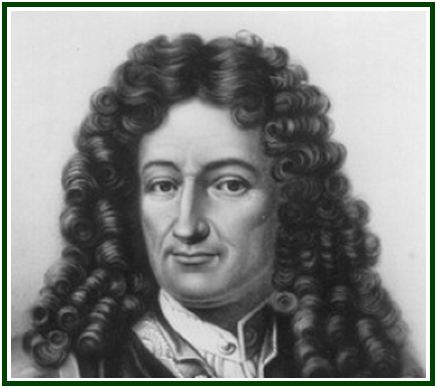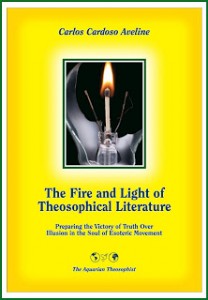
German Philosopher Builds a Bridge
Between The Two Roads to Knowledge
Between The Two Roads to Knowledge
Steven H. Levy

Gottfried Leibniz, or Leibnitz (1646-1716)

So far, there remains a chasm between the ideas of modern physical science and those of the Esoteric Philosophy on the nature of the atom.
The former is incapable of answering the psychological and metaphysical side of the question and prefers to examine only the external physical properties of things. The latter teaches that there is no such thing as inorganic lifeless substance. Even the chemical atoms are endowed with force and life.
For the scientist the bridge between matter on one side and consciousness, intelligence and life-force on the other may be found in the theories of the philosopher and mathematician Gottfried Leibniz (1646-1716).
Leibniz may be considered one of the great thinkers of the 17th and 18th Centuries. He developed calculus independently from Isaac Newton, formulated mathematical notations that are still used today, and lay the foundation for the modern digital computer by defining what has become the modern binary system and developing the first mass-produced mechanical calculator. He also developed a philosophy of mind and a theory of the monad. The term “monad” was first used by Leibniz to describe indivisible immaterial soul-like entities. Leibniz taught that all objects where endowed with an active principle or force. They were not lifeless or inert – which is the claim of the Esoteric Philosophy.
Gottfried Leibnitz, or Leibniz as he preferred to spell his name, has been called one of the “last universal geniuses” because he is considered by many to have been one of the last in a lineage of intellectual geniuses to have a universal grasp of knowledge. Although he is mostly remembered for his accomplishments in philosophy and mathematics, he had a remarkable encyclopedic knowledge and made contributions to many fields of human endeavor.
The uniqueness of his genius was the blending of intuitive and rational philosopher, practical and theoretical mathematician, psychological and physical scientist, ethicist and political-social reformer. Although he was not an Initiate or Mystic, he attempted to construct a synthesis of Science, Religion and Philosophy and a universal philosophical language. His understanding of the Monad comes very close to that of the Esoteric Philosophy of “The Secret Doctrine.” [1]
As a philosopher he began with universal conceptions. Unlike Descartes, who regarded thought and matter as two different, separated, and irreducible substances, Leibniz taught that thought and matter were two attributes of one universal unity he saw as God. He conceived of a plurality of substances and an infinitude of divine and semi-divine beings proceeding from the, and situated in the, One Reality. As the spiritual essence vivifying all these beings was one, he concluded that there must be an infinite gradation of thought and that the entire universe is endowed with consciousness.
For Leibniz, the ultimate unit of the universe was not a physical atomic particle, rather it was a center of spiritual, intelligent force capable of interacting with other centers to produce all the spiritual and physical phenomena. He called these uncompounded, elementary, indestructible units – or souls – “Monads.” He invented the term “apperception” to express the state of Monadic consciousness, and distinguished it from the self-consciousness of the human being.
As a scientist he evolved his theories from observed phenomena and reasoning from particulars to universals. He observed that a only a small portion of our thoughts rise into the light of self-conscious awareness and many remain in a confused or obscured state of perception for awhile, yet they are still there. He concluded that there is a wide range of mental life hidden from our perception but still present in all the kingdoms of nature. He also observed that external objects only appear to extend in space because of the capacity of our gross physical senses. He concluded that as matter is divided into infinitely small parts, or atoms, at some point it can no longer be said to extend geometrically in space, but its spiritual essence can extend infinitely in the metaphysical realm of thought.
As a mathematician he understood that a geometrical figure such as a cone stands on a mathematical point and that a perpendicular line intersects a horizontal line at a mathematical point even though they can extend infinitely in height and depth. He concluded that an atom was only a mathematical point in space that in reality extended infinitely into the inner realm of universal thought.
His views indefinitely extend within the atom the realm of conscious life. As a result he breaks down the contrast between animate and inanimate matter. Both are vivified by the monadic essence that, embracing the potential of all material forms and degrees of intelligence, mirrors the entire universe. Indeed, it is the entire universe in reality. Everything that comes forth from the Monad does so under natural law. Hence, he daringly called our earthly experience “the best of all possible worlds.”
As a moral philosopher, Leibniz equated ethics with the science of law. He viewed God as the supreme monad that is the infinite absolute reality and unity. He declared that God was all good that established harmony among all things. He taught that the ethical life was the attempt to imitate God.
The description by Leibniz on the nature of the monads is practically identical to that of the Esoteric Philosophy; however, there is an important distinction between the two systems.
Both agree that the essence of every monad is one living active spiritual force. So, that while each monadic unit is a soul different from every other monadic unit, every monad in its spiritual essence is the expression and mirror of the universe.
For Leibniz, the entire universe is represented in the monads. Some of its portions are reflected in one monad, and some in another. This gives them a qualitative and even quantitative difference from each other.
Leibniz formulates the idea that monads are souls whose inherent nature is to act. They are not passive mirrors of the universe. They are active agents whose images produce the universe. The inherent creative quality of the monad is also taught in the Esoteric Philosophy.
“Monads, he thought (as we do), are everywhere. Thus the human soul is a monad and every cell in the human body has its monad, as every cell in animal, vegetable, and even in the (so-called) inorganic bodies.” (“The Secret Doctrine”, vol. I, p. 630, fn)
Where the view of Leibniz diverges from the Esoteric Philosophy is in the fact that he makes no provision for the evolution of the monads, nor does he distinguish between the “monad” of an elemental, human monad, high planetary spirit, or Dhyan–Chohan. According to H.P. Blavatsky, the concepts of Leibniz “ however incomplete and faulty from the standpoint of Occultism, show a spirit of metaphysical intuition to which no man of science, not Descartes – not even Kant – has ever reached.” (“The Secret Doctrine”, vol. I, p. 627)
NOTE:
[1] “The Secret Doctrine”, Helena P. Blavatsky, Theosophy Co., Los Angeles.
000
On the role of the esoteric movement in the ethical awakening of mankind during the 21st century, see the book “The Fire and Light of Theosophical Literature”, by Carlos Cardoso Aveline.

Published in 2013 by The Aquarian Theosophist, the volume has 255 pages and can be obtained through Amazon Books.
000